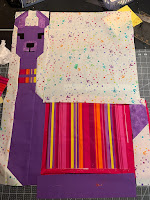I have had a LOT of adventures since last posting to this website, and have feel pretty guilty about not sharing with everyone. This is a turtle designed by myself and my daughter, Taylor, as a present to a young lady in order to gift her with a pet turtle that didn't come with a lot of housekeeping duties or salmonella.
You might notice that this turtle has felted hearts all over its shell-- another upside of a woven animal.
My favorite aspect of this particular woven turtle is that it can actually pull its head and legs into the shell (with some help from pokey fingers).
The top turtle shell was woven from two 4" x 6" rectangles that were overlapped to create a dome. The corners of the rectangles were turned under. The head was made with two 2" x 4" rectangles, stuffed. The feet and legs were each made with one 2" x 4" rectangle with the sides turned under to make an approximate 1" x 4" limb. The feet had a little bit of stuffing added to them. I added a darker color yarn on the edge of the feet to look like claws.
I made room for the retractable head and legs by weaving a 4" x 4" and using it to capture all the stuffing for the shell. That left an open section below where the head and legs are fastened. They can either stick out or be pulled in. I was really surprised at how well it worked.
Here is one more shot of our intrepid turtle... not actually in her natural environment... since her natural environment is really my yarn room.
And like this turtle I am going to try to spend more time out of my shell, exploring the world and sharing with others.
Talk to you soon. Meg Stump

































